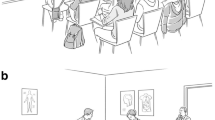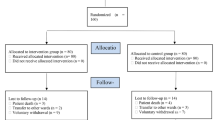Abstract
Objective
To ascertain the usefulness of a simulated clinical scene with actors in the classroom (theatrical performance) as a teaching tool for the management of falls and their related injuries.
Design
Experimental design of two related groups.
Setting
Spain.
Participants
A group of 12 students attended a seminar in which the approach to a clinical case was made using a simulated scene with actors in the classroom (scene group); a non-scene group of 34 students attended the seminar, without a theatrical performance (the same clinical case was read and presented in a traditional manner, oral presentation).
Measurements
Before and after the seminar, students answered a questionnaire [five questions on theoretical knowledge of falls and osteoporosis (score 0–10) and two on subjective learning perception (linear scale: 0–10) (score 0–20)]. In the scene group were two further questions included at the end on their opinion of the scene and on the seminar overall.
Results
Both groups significantly improved in all questionnaire scores after the seminar (p=0.001). The scene group had a greater rise in mean points of the questionnaire before and after the seminar than the non-scene group: theoretical knowledge [3.81±1.69 versus 2.75±1.33 (p=0.033)], subjective questions [6.08±4.10 versus 4.97±2.24 (p=0.247)], and the questionnaire overall [9.89±4.98 versus 7.72±2.66 (p=0.060)]. The scene group had a very good opinion of the usefulness of the scene and of the overall opinion of the seminar: 9.08±0.95 and 9.41±0.79.
Conclusions
Theatrical performance in the classroom seems to promote better learning than classic oral presentation, providing qualitative value by adding creativity and different approaches to the teaching of medicine.



Similar content being viewed by others
References
Formiga F, Rivera A, Nolla JM, Pujol R. Characteristics of falls producing hip fracture in an elderly population. Gerontology. 2004; 50: 118–9.
Lázaro del Nogal M, González Ramirez A, Palomo Lloro P. Evaluación del riesgo de caídas. Protocolos de valoración clínica. Rev Esp Geriatr Gerontol. 2005; 40: 54–63.
Lázaro del Nogal M. Caídas en el anciano. Med Clin (Barc). 2009;133:147–53.
Palmer K, Onder G, Cesari M. The geriatric condition of frailty. Eur J Int Med 2018; 56: 1–2.
Hopewell S, Adedire O, Copsey BJ, Boniface GJ, Sherrington C, Clemson L, Close JCT, Lamb SE. Multifactorial and multiple component interventions for preventing falls in older people living in the community (Review). Cochrane Database of Systematic Reviews 2018, Issue 7. Art. No.: CD012221. DOI: https://doi.org/10.1002/14651858. CD012221.pub2. http://www.cochranelibrary.com
Rubenstein LZ, Powers CM, MacLean CH. Quality indicators for the management and prevention of falls and mobility problems in vulnerable elders. Ann Intern Med. 2001;135 (8, pt 2): 686–693.
Wendt K, Heim D, Josten C, Kdolsky R, Oestern HJ, Palm H, Sintenie B, Komadina R, Copuroglu C. Recommendations on hip fractures. Eur J Trauma Emerg Surg 2016; 42: 425–431.
Bateman L, Vuppala S, Porada P, Carter W, Baijnath Ch, Burman K, Lee R, Hargus J. Medical Management in the Acute Hip Fracture Patient: A Comprehensive Review for the Internist. Ochsner J. 2012 Summer; 12(2): 101–110
Porcel JM, Casademont J, Conthe P, Pinilla B, Pujol R, García-Alegría J. Core competencies in internal medicine. Eur J Intern Med. 2012 Jun; 23:338–41.
Cranston M, Slee-Valentijn M, Davidson C, Lindgren S, Semple C, Palsson R; European Board of Internal Medicine Competencies Working Group. Postgraduate education in internal medicine in Europe. Eur J Intern Med. 2013;24:633–8.
Elley CR, Clinick T, Wong C, Arroll B, Kennelly J, Doerr H, Moir F, Fishman T, Moyes SA, Kerse N. Effectiveness of simulated clinical teaching in general practice: randomised controlled trial. J Prim Health Care. 2012; 4: 281–287.
Roberts D. Vicarious learning: A review of the literature. Nurse Educ Pract 2010:10;13–16.
O’Regan S, Molloy E, Watterson L et al. Observer roles that optimize learning in healthcare simulation education: a systematic review. Adv Simul 2016; 1:4. https://doi.org/10.1186/s41077-015-0004-8.
Robles MJ, Esperanza A, Pi-Figueras M, Riera M, Miralles R. Simulation of a clinical delirium scenario with actresses in the classroom: a useful method of learning clinical delirium management. Eur Geriatr Med 2017; 8:474–479.
Cohen J. Statistical power analysis for the behavioral sciences. Hillsdele NJ. Lawrence Erlbaum Associates. New York NY: Academic Press, 1988.
Casado A, Prieto L, Alonso J. El tamaño del efecto de la diferencia entre dos medias: ¿estadísticamente significativo o clínicamente relevante?. Med Clin (Barc). 1999;112:584–588.
Fisher JM, Walker RW. A new age approach to an age old problem: using simulation to teach geriatric medicine to medical students. Age Ageing. 2014; 43:424–428.
Rossiter K, Kontos P, Colantonio A, Gilbert J, Gray J, Keightley M. Staging data: theatre as a tool for analysis and knowledge transfer in health research. Soc Sci Med. 2008; 66:130–46.
Case GA, Brauner DJ. Perspective: the doctor as performer: a proposal for change based on a performance studies paradigm. Acad Med 2010;85:159e63).
Shapiro J, Hunt L. All the world’s a stage: the use of theatrical performance in medical education. Med Educ 2003; 37: 922–927.
Unalan PC, Uzuner A, Cifçili S, Akman M, Hancioglu S, Thulesius H. Using theatre in education in a traditional lecture oriented medical curriculum. BMC Med Educ. 2009; 9: 73 doi:https://doi.org/10.1186/1472-6920-9-73.
Jacobsen T, Baerheim A, Lepp MR, Schei E. Analysis of role-play in medical communication training using a theatrical device the fourth wall. BMC Med Educ. 2006; 6:51. doi:https://doi.org/10.1186/1472-6920-6-5110.
Nourhashémi F, Andrieu S, Gillette-Guyonnet S, Vellas B, Albarède JL, Grandjean H. Instrumental activities of daily living as a potential marker of frailty: A study of 7364 community-dwelling elderly women (the EPIDOS Study). J Gerontol 2001; vol 56A: M448–M453.
Viccaro LJ Perera S Studenski SA. Is timed up and go better than gait speed in predicting health, function, and falls in older adults? J Am Geriatr Soc. 2011;59:887–892. doi:https://doi.org/10.1111/j.1532-5415.2011.03336.x
Raîche M, Hébert R, Dubois MF, and the PRISMA partners. User guide for the PRISMA-7 questionnaire to identify elderly people with severe loss of autonomy. In integrated service delivery to ensure persons’ functional autonomy, ed. R. Hébert, A. Tourigny, and M. Gagnon, 147–65. Quebec: Edisem.
Tinetti ME. Preventing falls in elderly persons. N Engl J Med 2003;348:42–49.
Bischoff-Ferrari HA, Dawson-Hughes B, Staehelin HB, Orav JE, Stuck AE, Theiler R, et al. Fall prevention with supplemental and active forms of vitamin D: a meta-analysis of randomised controlled trials. BMJ 2009;339:b3692. DOI: https://doi.org/10.1136/bmj.b3692.
Universitat Autònoma de Barcelona. Codi de bones pràctiques en la recerca. [Disponible en: https://www.uab.cat/doc/codibonespractiques_recerca (accedido el 29 de diciembre 2018)].
Acknowledgements
The authors are grateful to Christine O’Hara for assistance with the English version of the manuscript.
Author information
Authors and Affiliations
Corresponding author
Ethics declarations
Disclosure statement: The authors declare no conflict of interest.
Ethical aspects: The use of simulated patients is common at our university. Students are accustomed and it is not perceived as something new or experimental. Since the research does not directly involve persons, material of human origin or experimental animals, ethical approval for the study was not required according to the current regulations at our university (28). At the beginning of the seminar, all students were informed of the methodology and contents. Oral consent was given by all. Participation in the seminar was in the context of the normal academic course. Furthermore, attending as one seminar group or the other was not a disadvantage from the academic point of view. Students’ data and results were treated as part of their normal course in the academic activity of the university; however in the study, data of the students were used anonymously.
Rights and permissions
About this article
Cite this article
Robles, M.J., Esperanza, A., Arnau-Barrés, I. et al. Frailty, Falls and Osteoporosis: Learning in Elderly Patients Using a Theatrical Performance in the Classroom. J Nutr Health Aging 23, 870–875 (2019). https://doi.org/10.1007/s12603-019-1272-0
Received:
Accepted:
Published:
Issue Date:
DOI: https://doi.org/10.1007/s12603-019-1272-0




